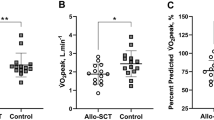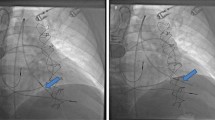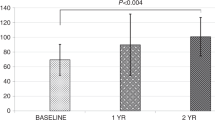Abstract
Sixty-three patients who had undergone a BMT at age ⩽18 years were evaluated cross-sectionally to determine cardiac function as well as the long-term prevalence, types, severity, and risk factors of cardiac abnormalities. Patients were ⩾1 year post-BMT and were evaluated by history, resting ECG, echocardiography (ECHO), exercise treadmill test, chest X-ray, pulmonary function tests and review of past cardiac studies. Patients were assigned a New York Heart Association (NYHA) class based on an activity and cardiac symptoms questionnaire. Pretransplant preparative regimens included high-dose cyclophosphamide (CY) and total body/lymphoid irradiation (n = 38), CY in combination with other chemotherapy (n = 22), and other drug combinations (n = 3). Forty patients (63.5%) had received prior anthracyclines (median 307 mg/m2). Patients’ ages ranged from 1.9 to 32 years (median 10.9 years) with median follow-up of 3.3 years (range 1–16.3 years). Twenty-six patients (41.3%) had a cardiac abnormality detected at follow-up. In 21 patients the abnormal finding had not been present at the pre-BMT evaluation. Ten patients (16.4%) had resting ECG abnormalities. Left ventricular ejection fraction (LVEF) by ECHO was mildly decreased to 50–54% in three patients and markedly decreased to 40% in one patient. Only one patient (1.7%) developed a mildly abnormal shortening fraction of 27%. All patients with ECHO abnormalities were asymptomatic. Twenty-three of 31 patients ⩾9 years of age (74%) who underwent a treadmill exercise test had a borderline or abnormal response to exercise. There was no correlation between demographic factors, previous therapy, preparative regimen or length of follow-up with the post-BMT ECG, ECHO and treadmill abnormalities. Overall, eight patients (12.7%) were symptomatic and NYHA class II or III, and all had abnormal exercise tests. The presence of symptoms and NYHA class were predictors for oxygen consumption during exercise (P = 0.03 and 0.02, respectively) and tended to predict overall treadmill results also. Late cardiac abnormalities do occur following BMT in childhood and thus, there is a clear need for continued, serial long-term cardiac evaluation in transplant survivors. Evaluations should include exercise stress testing to detect inadequate cardiac output as well as oxygen consumption during exercise.
This is a preview of subscription content, access via your institution
Access options
Subscribe to this journal
Receive 12 print issues and online access
$259.00 per year
only $21.58 per issue
Buy this article
- Purchase on Springer Link
- Instant access to full article PDF
Prices may be subject to local taxes which are calculated during checkout
Similar content being viewed by others
Author information
Authors and Affiliations
Rights and permissions
About this article
Cite this article
Eames, G., Crosson, J., Steinberger, J. et al. Cardiovascular function in children following bone marrow transplant: a cross-sectional study. Bone Marrow Transplant 19, 61–66 (1997). https://doi.org/10.1038/sj.bmt.1700600
Received:
Accepted:
Issue Date:
DOI: https://doi.org/10.1038/sj.bmt.1700600
Keywords
This article is cited by
-
Does allogeneic stem cell transplantation in survivors of pediatric leukemia impact regular physical activity, pulmonary function, and exercise capacity?
Molecular and Cellular Pediatrics (2021)
-
Cardiorespiratory fitness and physical performance after childhood hematopoietic stem cell transplantation: a systematic review and meta-analysis
Bone Marrow Transplantation (2021)
-
Determinants of cardiorespiratory fitness in very long-term survivors of allogeneic hematopoietic stem cell transplantation: a national cohort study
Supportive Care in Cancer (2021)
-
Changes in Bi-ventricular Function After Hematopoietic Stem Cell Transplant as Assessed by Speckle Tracking Echocardiography
Pediatric Cardiology (2018)
-
Aerobic exercise capacity at long-term follow-up after paediatric allogeneic haematopoietic SCT
Bone Marrow Transplantation (2014)



